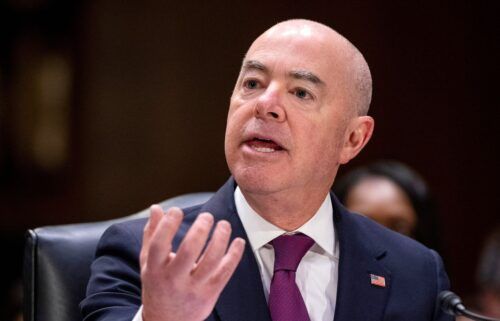Even with Republican infighting, Democrats face significant headwinds in 2022
Democrats faced with holding the party’s majority in the House in 2022 watched with glee this week as Republican infighting reached its latest crescendo with the leadership ouster of Rep. Liz Cheney. But it’s their own party that faces the most noteworthy headwinds in their bid to keep control of the legislative body.
A sweep of factors — an already narrow majority, the history of the party controlling the White House ceding ground in the subsequent midterms, the uncertainty of Republican-dominated redistricting and Republicans nationwide pursuing restrictive voting bills — have Democrats anxious about their chances in 2022.
Democrats are hopeful they can buck historic trends, primarily by spending millions to keep legislation signed by President Joe Biden popular over the next 18 months. But congressional Democrats, many of whom won their seats during the 2018 election that was seen as a rejection of then-President Donald Trump’s first two years in office, acknowledge that no level of GOP drama will make running in swing districts any easier.
“No one’s talking about Liz Cheney in my district right now,” said Rep. Elissa Slotkin, a Democrat who represents a Michigan district that backed Trump in both 2016 and 2020. “They want to know what’s happening with their pocketbooks and their kids. … They know what’s going on with the things that directly impact them, so we need to be able to speak to economic security.”
The party currently only has a seven-seat majority in the House, meaning even the slightest shift in November 2022 could cost the party their majority. And Republicans are already working to shift the public conversation from popular bills like the coronavirus relief package to more controversial issues like immigration, rising inflation and questions about Biden’s handle on the economy.
The most uncertain factor facing Democrats is redistricting, which will mean significant changes to districts across the country. The unclear process has frozen the field in some key areas, with would-be candidates waiting to decide whether to run for office until the new maps are released. The failure of Democrats to win back any state legislatures in 2020 and the near total Republican control in states like Florida, Texas and Ohio has only ratcheted up the pressure on this process.
A raft of retirements — with more anticipated — has also further complicated the 2022 map for Democrats, turning seats that once benefited from Democratic incumbents into serious stretch races for the party. And hanging over all of this is history — the party that won the White House two years earlier often suffers significant losses in the subsequent midterms, a fact Democrats inside the White House were considering mere weeks into President Joe Biden’s term.
“Our report card is going to be, are people living better lives a year from now. And if they are, I think we’re going to be in good shape,” said Rep. Josh Harder, a Democratic congressman from a battleground district in California. “I think we’re off to a good start. … The challenge is we have to keep it going.”
‘Our brand is not strong’
Biden is no stranger to midterm fights. He was vice president in 2010 when the Democratic Party took what then-President Barack Obama called a “shellacking” in the midterms and ceded the House majority to Republicans.
People close to Biden tell CNN that the President has already expressed an eagerness to get out on the midterm campaign trail, believing that his policies — if touted effectively — will remain popular and help Democrats, something that was not the case in 2010 with the newly passed Affordable Care Act.
The popularity of Biden himself and the bills he gets through Congress will be central to any chance Democrats may have at bucking history.
The Democratic National Committee announced this month that they plan to spend $20 million this year to tout Biden’s achievements and put people on the ground in key states like Arizona, Florida, Georgia, Michigan, North Carolina, Pennsylvania and Wisconsin. The committee, led by new chair Jaime Harrison, sees that money as a down payment for 2022, said party aides, adding it will only increase next year.
All of this is aimed at keeping public sentiment on Biden’s side. Top operatives argue that unlike the first years of the Trump presidency, where Republicans ventured to gut Obama’s trademark healthcare law and successfully passed tax cuts that overwhelmingly benefited wealthy Americans, Biden and Democrats began by passing a broadly popular coronavirus relief bill and are now working to pass a similarly popular infrastructure package.
But Democrats know that Biden won’t be able to focus solely on issues that are broadly popular, especially as their base demand action on thornier issues like immigration and police reform. And Republicans, no matter how popular Biden’s plans may be, are set to seize on any break in the party or slight economic downturn to attack candidates in swing districts.
The concern for someone like Slotkin, who could once again be tasked to run for reelection in an area that leans Republican, is that the power of the Democratic brand may not be strong enough to rebut those attacks.
“The attacks are always going to be there,” the congresswoman said. “The problem we have is that our brand is not strong, our underlying brand, so that when the latest attack comes out, a certain percentage of people believe it because they don’t always know what we’re about.”
She added: “And this is where I get back to economic security and focusing like a laser on the things that keep people up at night and that’s different from the beltway chatter.”
The Democratic Congressional Campaign Committee has initially released a narrower set of congressional targets for the midterms, including one open race and 21 seats currently held by Republicans. The heart of the Democratic efforts is in America’s suburbs, the growing and diversifying communities around the country’s largest cities where the party made headway under Trump and helped deliver the party the majority in 2018.
Retirements loom
Congressional retirements happen every year, but the uncertainty of a midterm election amid redistricting has both parties worried the departures could begin to stack up.
Democrats have already seen a litany of swing seat retirements. The latest was Illinois Rep. Cheri Bustos announcing she would not seek reelection, depriving Democrats of an incumbent to run in a district Trump won in both 2016 and 2020.
Rep. Filemon Vela, a Texas congressman who represents an area in South Texas where Republicans made inroads in 2020, and Rep. Ann Kirkpatrick, a congresswoman who represents a South Arizona district that narrowly leans Democratic, also both announced they were retiring at the end of this Congress. In Florida, three Democratic members — Charlie Crist, Stephanie Murphy and Val Demings — are expected to leave the House to seek statewide office. And in Ohio, Rep. Tim Ryan announced a Senate campaign.
“The half-life of a swing district member of Congress is a lot shorter than the half-life of a member of Congress from a safe seat,” said Harder, whose Central Valley district in California went for Biden in 2020 by less than 3 percentage points. “Part of it is obviously the electoral headwinds — it’s tough to defy gravity in swing districts indefinitely — but the other piece of it is it’s just a really tough situation representing a community that’s 50-50.”
Unlike redistricting, where Republicans acknowledge there is only so much help the process can provide, GOP party operatives are bullish that retirements could help them win districts like Bustos’ in Illinois and Kirkpatrick’s in Arizona.
“These retirements can signal several things,” said Matt Gorman, a Republican operative who worked for the National Republican Congressional Committee in 2018, when retirements exposed his party to difficult open races. “Either they see the writing on the wall or don’t have the stomach for a tough campaign. Often, they believe it’s better to bow out gracefully than run hard and lose.”
While Republicans have also faced retirements, these have come from solidly Republican districts that would almost certainly elect a Republican in 2022.
Republican Reps. Tom Reed of New York, Jody Hice of Georgia and Kevin Brady of Texas have all announced plans to retire at the end of this Congress, but all represent solid red districts. And Rep. Steve Stivers, an Ohio Republican who represents parts of Columbus and rural areas south of the City, is set to leave Congress this month, but his district is also solidly Republican.
The great unknown
The greatest uncertainty for Democrats comes from redistricting, the process where congressional lines in every state are redrawn each decade based on demographic changes. Initial numbers released by the US Census saw growth in states where Republicans dominate the redistricting process, like Florida and Texas, while more Democratic states like New York, California and Illinois are all slated to lose a seat in Congress.
One of the greatest impacts of redistricting could be how it has frozen the field of possible candidates in numerous competitive congressional districts. Democratic operatives told CNN that they have heard from would-be candidates who are putting off declaring their candidacy — and thereby starting the fundraising and organizing process — because it is unclear how each district will be drawn.
“Redistricting has caused a great deal of unknown — candidates don’t know what districts will look like, incumbents don’t know what districts they will be running in,” said Jesse Ferguson, a longtime Democratic operative who worked at the Democratic Congressional Campaign Committee for three cycles. “There are countless candidates out there who are thinking about running and planning to run but won’t be able to move forward until they know what those districts actually will look like.
This is particularly acute for someone like Slotkin, whose home state of Michigan is slated to lose a seat in Congress, almost ensuring that her district will look different once the state’s independent commission is done drawing the new lines.
“I honestly do not know what my district will look like a year from now,” she said. “So that is a big open question for a lot of us in Michigan and a lot of other places.”
For a party with a slim majority in the House already, this forced freeze has people worried. But even Republicans admit that redistricting will only get the party so far. To win back the House, Republican operatives said, it will be critical to make Biden’s policies unpopular.
“Redistricting isn’t going to deliver Republicans a majority,” said Michael McAdams, spokesman for the National Republican Congressional Committee. “We are going to have to run competitive races all across the country and if we have that mindset, we are going to be in a good spot come November 2022.”



